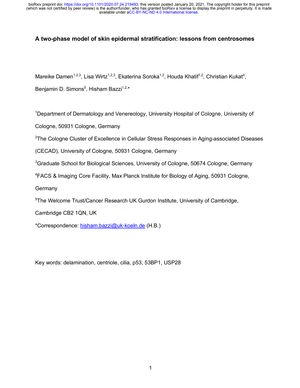A Two-Phase Model of Skin Epidermal Stratification: Lessons from Centrosomes
July 2020
in “
bioRxiv (Cold Spring Harbor Laboratory)
”
skin epidermal stratification cell division orientation basal keratinocyte progenitors centrosomes mitotic spindle mitotic surveillance pathway p53 53BP1 USP28 epidermal differentiation basal transit-amplifying cells suprabasal transit-amplifying cells cell delamination tissue homeostasis hyperproliferation

TLDR Removing centrosomes from skin cells leads to thinner skin and stops hair growth, but does not greatly affect skin cell differentiation.
The study investigated the initiation and progression of skin epidermal stratification, focusing on the role of cell division orientation in basal keratinocyte progenitors. Researchers genetically removed centrosomes, which organize the mitotic spindle, from developing epidermis and observed the activation of a mitotic surveillance pathway involving p53, 53BP1, and USP28, resulting in a thinner epidermis and halted hair follicle development. Despite changes in division orientation in centrosome/p53-double mutant keratinocyte progenitors during later stages, epidermal differentiation was not significantly affected. Time-lapse imaging and tissue growth dynamics measurements indicated that the initial phase of epidermal stratification is driven by high proliferation rates of basal and suprabasal transit-amplifying cells and cell delamination, while the second phase may not depend on the division orientation of basal progenitors. This research provides insights into tissue homeostasis and diseases characterized by hyperproliferation, which may mimic developmental processes.

